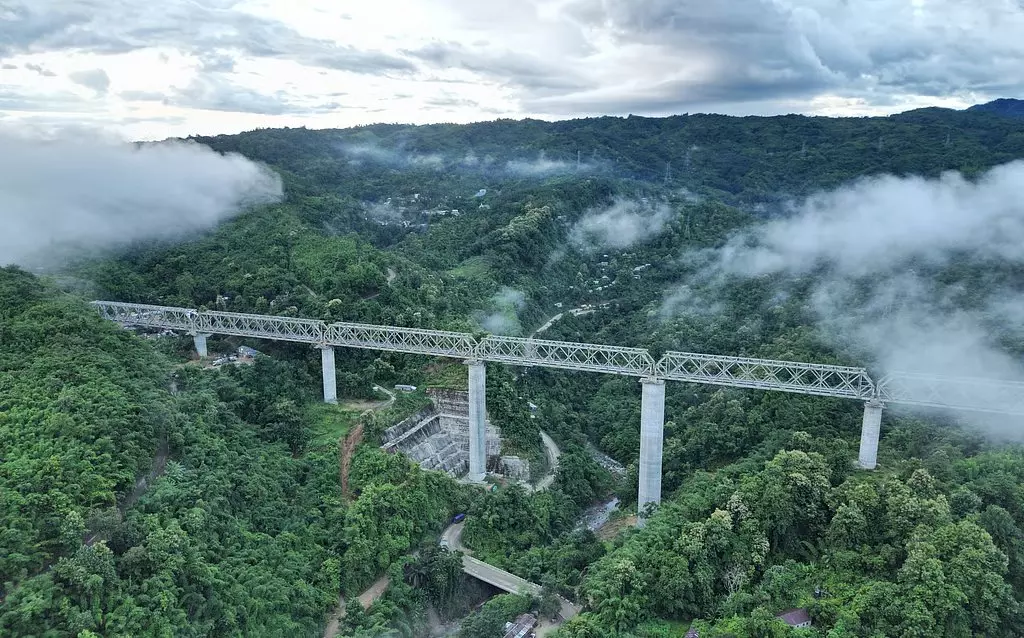
Know about India’s toughest railway line, built in Aizawl after 17 years of toil
After battling landslides, steep gorges, and soft rock collapses, the ₹8,071-crore Bairabi–Sairang railway project is now complete; Modi inaugurates it tomorrow

More than 170 years after the advent of railways in India, Mizoram’s capital Aizawl is finally poised to be connected to the country’s vast railway network.
The inauguration of the Bairabi–Sairang railway line on September 13, by Prime Minister Narendra Modi, will mark a historic milestone — not just for Mizoram, but also for Indian Railways, which has completed what is considered the most technically demanding railway line in the country.
Spanning 51.38 km, the Bairabi–Sairang section is being hailed as India’s toughest railway construction due to its extreme terrain, complex geological challenges, and unforgiving weather patterns. The project involved the construction of 45 tunnels and 153 bridges, traversing steep hills, deep gorges, and densely forested regions — making it an extraordinary feat of engineering.
Watch | Is Manipur back to 'normal' ahead of PM Modi's visit?
The line, which extends rail connectivity closer to Aizawl — located just 20 km from Sairang — was first sanctioned in 2008 in the UPA government of Manmohan Singh. Modi laid the foundation stone in 2014, and after more than a decade of construction, the final leg between Hortoki and Sairang was commissioned on June 10, 2025.
IR's broader initiative
The broad-gauge railway line connecting Bairabi in Mizoram’s Kolasib district to Sairang forms part of Indian Railways’ (IR) broader initiative to link all northeastern state capitals with the national railway network.
Among the eight northeastern states, only the capitals of Assam (Guwahati), Arunachal Pradesh (Itanagar), and Tripura (Agartala) currently have functional rail connectivity. Itanagar’s rail link was established on April 7, 2014, via the Naharlagun station.
Projects to connect the remaining capitals are in progress. These include railway lines from Jiribam to Imphal (Manipur), Dimapur to Zubza near Kohima (Nagaland), Sivok to Rangpo near Gangtok (Sikkim), and Byrnihat to Shillong (Meghalaya). However, the Shillong project has encountered local opposition due to concerns about potential demographic shifts in the absence of an Inner Line Permit (ILP) framework.
Cross-border rail connectivity
The Bairabi–Sairang line is also considered a stepping stone for cross-border rail connectivity with Myanmar. A preliminary survey for a proposed 223-km extension from Sairang to Hmawngbuchhuah, near the India–Myanmar border, was completed in August 2015.
Also read | How Majuli, Assam’s river island, struggles to keep its monasteries, mask art alive
This extension is envisioned to link with Myanmar’s Kaladan Multi-Modal Transit Transport Project in Rakhine State. According to North East Frontier Railway spokesperson Nilanjan Deb, a final location survey for the route is currently underway.
In a similar effort, the 111-km Jiribam–Imphal line, which is under construction, is planned to extend further to Moreh, a strategic border town. The segment up to Imphal is projected to be completed by 2028, with feasibility studies ongoing for the Moreh extension.
Look East Policy
These infrastructure efforts align with India’s “Look East Policy,” introduced during the UPA era, which aimed to bolster connectivity with Southeast Asia.
As part of this policy, an Inter-Governmental Agreement on the Trans-Asian Railway was signed by then Railway Board Chairman JP Batra at the United Nations headquarters in New York on June 29, 2007, laying the groundwork for India’s rail expansion in the northeastern frontier.
Most difficult railway project
What sets apart the Bairabi-Sairang project is not just its cost of ₹8,071 crore or the number of bridges and tunnels, but the sheer scale of challenges overcome. Heavy monsoon rainfall limited work to just four to five months a year. Engineers had to battle unstable soft rock formations prone to faults, fractures, and water ingress, frequently leading to collapses.
Also read | First freight train enters Kashmir, connects Valley with national network
Adding to the logistical complexity was the lack of basic construction materials in Mizoram. Essential inputs like sand, aggregates, and stones had to be transported from distant states such as Assam, West Bengal, Bihar, Jharkhand, and Meghalaya, often via both rail and road.
"This has been one of the most demanding rail projects we've executed," said Deb,, spokesperson for the Northeast Frontier Railway (NFR), highlighting how the terrain and climate created near-impossible working conditions.
Transformational impact
Despite the challenges, the completion of this line marks a transformative moment for the region. The new connectivity will cut travel time between Bairabi and Sairang from seven hours to just three, improving access to healthcare, education, and markets in major cities such as Guwahati, Silchar, Kolkata, and Delhi.
Four new stations — Hortoki, Kawnpui, Mualkhang, and Sairang — have been established as part of the project, creating new economic corridors and reducing regional isolation.
Residents in Kolasib and Aizawl districts are expected to benefit from affordable and efficient transportation.
Tourism push, economic benefits
To promote tourism in the region, the Indian Railway Catering and Tourism Corporation (IRCTC) signed a two-year agreement with the Mizoram government last. Under this collaboration, a special tourist train is planned as part of the ‘Discover NE (Northeast) Beyond Guwahati’ initiative, with Aizawl as a key destination.
The tourism partnership includes joint promotional campaigns, curated travel experiences, and enhanced logistics, aimed at boosting local employment in the hospitality sector and spurring broader economic development.
With this new rail link, Mizoram not only steps into the national rail grid but also sets a benchmark in overcoming geographical adversity to bring infrastructure to some of India's most remote regions.

